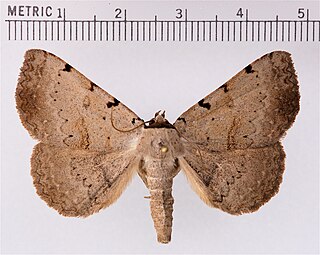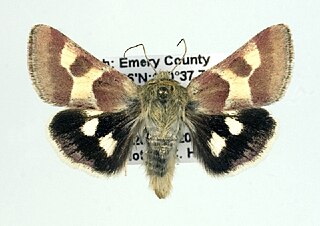
Chytolita is a monotypic litter moth genus of the family Erebidae erected by Augustus Radcliffe Grote in 1873. Its only species, Chytolita morbidalis, the morbid owlet moth or morbid owlet, was first described by Achille Guenée in 1854. It is found in large parts of North America, from coast to coast in the north and south to North Carolina, Texas and Florida in the west. The habitat consists of deciduous woods and edges.

Copanarta is a genus of moths of the family Noctuidae. The genus was erected by Augustus Radcliffe Grote in 1895.

Copivaleria is a monotypic moth genus of the family Noctuidae erected by Augustus Radcliffe Grote in 1883. Its only species, Copivaleria grotei, or Grote's sallow, was first described by Herbert Knowles Morrison in 1874. It is found in eastern North America, including Ontario, Tennessee, New York and Maryland.

Zanclognatha is a genus of litter moths of the family Erebidae. The genus was erected by Julius Lederer in 1857.

Hyperstrotia is a genus of moths of the family Erebidae. The genus was erected by George Hampson in 1910.
Ledaea is a genus of moths in the family Erebidae. The genus was erected by Herbert Druce in 1891.

Melanomma auricinctaria, the gold-lined melanomma moth, is the only species in the monotypic genus of moths Melanomma in the family Erebidae. It is found in the United States and Canada. Both the genus and species were first described by Augustus Radcliffe Grote in 1875.

Spiloloma is a monotypic moth genus in the family Erebidae. Its only species, Spiloloma lunilinea, the moon-lined moth, is found in eastern and south-central North America. Both the genus and species were first described by Augustus Radcliffe Grote in 1873.

Digrammia was a genus of moths in the family Geometridae erected by Carl Freiherr von Gumppenberg in 1887. It is now often considered a synonym of Semiothisa.

Globia subflava, the subflava sedge borer or yellow sedge borer, is a moth of the family Noctuidae. The species was first described by Augustus Radcliffe Grote in 1882. It is found in North America from Nova Scotia west to British Columbia, south to New Jersey in the east and Utah and California in the west.

Schinia suetus is a moth of the family Noctuidae first described by Augustus Radcliffe Grote in 1873. It is widespread in the mountains of western North America, from southern Alberta west to British Columbia, south at least to Colorado and California, east to Idaho and New Mexico.

Acronicta lupini, the lupine dagger or little bear, is a moth of the family Noctuidae. The species was first described by Augustus Radcliffe Grote in 1873. It is found from Quebec, Newfoundland and Labrador, British Columbia, Alberta and Yukon in Canada, south to California.

Aseptis fumosa is a moth of the family Noctuidae first described by Augustus Radcliffe Grote in 1879. It is widespread in western North America and is known from western Canada, Washington, Nebraska, Colorado, Utah, Arizona, Nevada and California. It occurs in a variety of diverse habitats including coast chaparral, dry conifer forest, and shrub steppe.

Paraseptis is a monotypic moth genus in the family Noctuidae erected by Tomas Mustelin and Lars G. Crabo in 2015. Its only species, Paraseptis adnixa, was first described by Augustus Radcliffe Grote in 1880. It is widely distributed along the Pacific Coast from northern Mexico to south-western British Columbia in a variety of forested habitats.

Acronicta insita, the large gray dagger or fingered dagger, is a moth of the family Noctuidae. The species was first described by Augustus Radcliffe Grote in 1874. It is found from Newfoundland west to the Pacific coast and Vancouver Island and Haida Gwaii, British Columbia, south to North Carolina and Colorado.

Diachrysia aereoides, the dark-spotted looper or lined copper looper, is a moth of the family Noctuidae. The species was first described by Augustus Radcliffe Grote in 1864. It is found in North America from Newfoundland west to northern California. It reaches its southernmost distribution in Great Smoky Mountains National Park.

Redectis vitrea, the scalloped snout or white-spotted redectis, is a litter moth of the family Erebidae. The species was first described by Augustus Radcliffe Grote in 1878. It is found in the United States from Illinois to south-eastern Massachusetts, south to Texas and Florida.

Leuconycta lepidula, the marbled-green leuconycta moth, marbled-green jaspidia or dark leuconycta, is a moth of the family Noctuidae. The species was first described by Augustus Radcliffe Grote in 1874. It is found in North America from Nova Scotia to North Carolina, west to Texas and north to Alberta.

Paleacrita merriccata, the white-spotted cankerworm moth, is a moth of the family Geometridae. The species was first described by Harrison Gray Dyar Jr. in 1903. It is found in eastern North America, where it has been recorded from central Illinois, eastern Missouri, west-central Mississippi, Louisiana and eastern Texas.
Digrammia sexpunctata, the six-spotted digrammia, is a moth in the family Geometridae described by J. Elwyn Bates in 1886. It is found in North America.

















